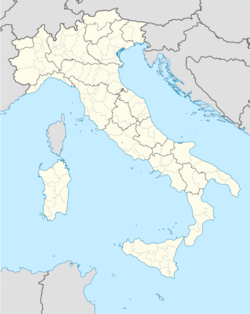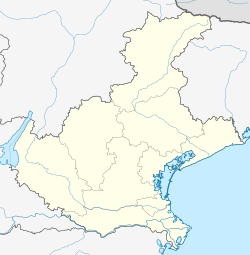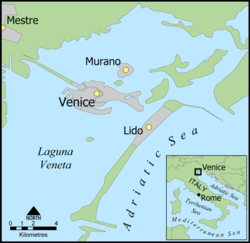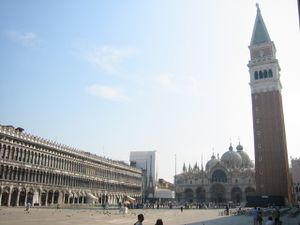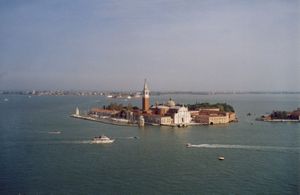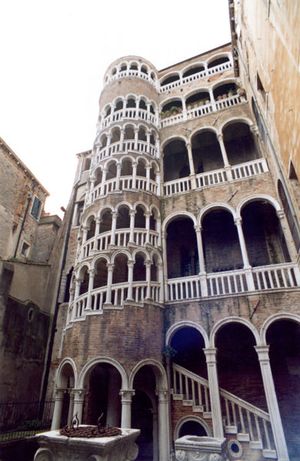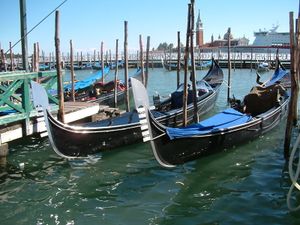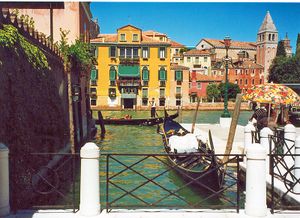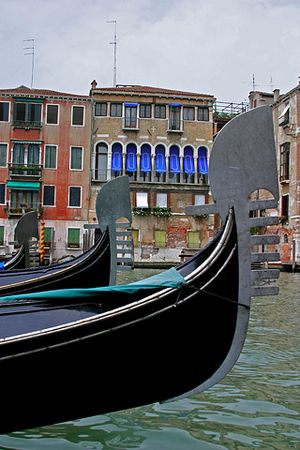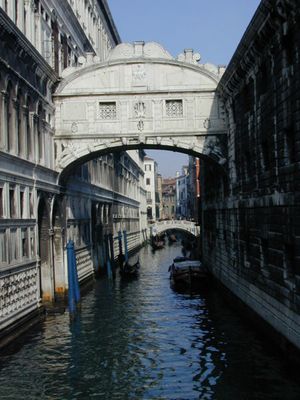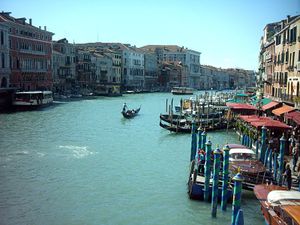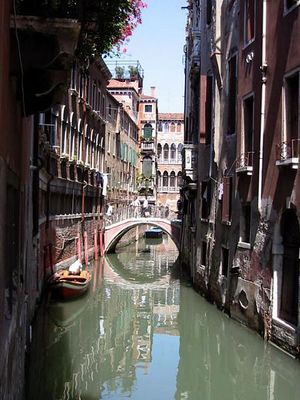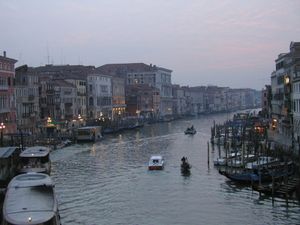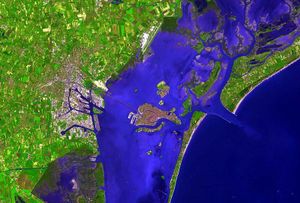البندقية
Venice
| |
|---|---|
| Comune di Venezia | |
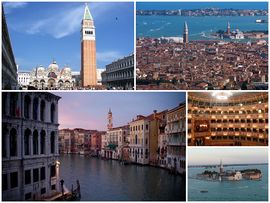 A collage of Venice: at the top left is the Piazza San Marco, followed by a view of the city, then the Grand Canal and interior of La Fenice, as well as the island of San Giorgio Maggiore. | |
| الإحداثيات: 45°26′15″N 12°20′9″E / 45.43750°N 12.33583°E | |
| البلد | إيطاليا |
| المنطقة | Veneto |
| المدينة العمرانية | Venice (VE) |
| Frazioni | Chirignago, Favaro Veneto, Mestre, Marghera, Murano, Burano, Giudecca, Lido, Zelarino |
| الحكومة | |
| • العمدة | Luigi Brugnaro ([[قائمة الأحزاب السياسية في إيطاليا|independent]]) |
| المساحة | |
| • الإجمالي | 414٫57 كم² (160٫07 ميل²) |
| المنسوب | 1 m (3 ft) |
| التعداد (2018) | |
| • الإجمالي | 260٬897 |
| • الكثافة | 630/km2 (1٬600/sq mi) |
| صفة المواطن | Veneziano Venetian (English) |
| منطقة التوقيت | UTC+1 (CET) |
| • الصيف (التوقيت الصيفي) | UTC+2 (CEST) |
| الرمز البريدي | 30100 |
| مفتاح الهاتف | 041 |
| Patron saint | St. Mark the Evangelist |
| يوم القديس | 25 April |
| الموقع الإلكتروني | Official website |
| موقع تراث عالمي حسب اليونسكو | |
|---|---|
 Venice in autumn, with the Rialto Bridge in the background | |
| السمات | Cultural: i, ii, iii, iv, v, vi |
| مراجع | 394 |
| التدوين | 1987 (11 Session) |
البندقية (بالإيطالية: Venezia, بالبندقية: Venezsia, بالإنجليزية: Venice, بالألمانية Venedig) هي مدينة في شمال إيطاليا, وعاصمة إقليم ڤـِنـِتو, وعاصمة مقاطعة فينيسيا, وتعداد سكانها 271,251 (تعداد تقديري 1 يناير, 2004). ومع پادوا, تندرج المدينة في منطقة پادوا-البندقية الحضرية (تعداد 1,600,000). وتعرف البندقية بلقب "La Dominante", "Serenissima", "ملكة الأدرياتيكي", "مدينة الماء", "مدينة الجسور", و "مدينة النور".
تمتد المدينة على 118 جزيرة صغيرة في بحيرة البندقية التي هي في الواقع مستنقع بمحاذاة البحر الأدرياتيكي في شمال شرق إيطاليا. البحيرة المالحة تمتد على طول الساحل بين مصبات أنهار پو (جنوباً) و پياڤه (شمالاً). ويقدر عدد السكان بنحو 272,000 نسمة بما فيهم سكان كل ال كومونه (مدينة) البندقية; وهم 62,000 في مدينة البندقية التاريخية (Centro storico); 176,000 في ترّا فـِرما Terraferma (الأرض الصلبة), ومعظمها في الأحياء frazione الكبيرة، ألا وهي Mestre و Marghera; و 31,000 يعيشون في جزر أخرى في البحيرة.
الجمهورية البندقية كانت قوة بحرية هامة في العصور الوسطى وعصر النهضة, وكانت منطلقاً |للحملات الصليبية و لمعركة لـِپانتو, وكذلك كانت مركزاً شديد الأهمية للتجارة (خصوصاً الحرير والحبوب وتجارة التوابل) والفن من القرن الثالث العشر حتى نهاية القرن السابع عشر.
المدينة عبارة عن عدة جزر متصلة ببعضها عن طريق جسور و تطل المدينة على البحر الأدرياتيكي. تعتبر المدينة من أهم المدن الايطالية ومن أكثر المدن جمالا في إيطاليا لما تتمتع به من مباني تاريخية يعود أغلبها إلى عصر النهضة في إيطاليا وقنواتها المائية المتعددة ما يجعلها فريدة من نوعها على مستوى العالم.
التاريخ
 مقالات مفصلة: تاريخ البندقية
مقالات مفصلة: تاريخ البندقية- جمهورية البندقية
الأصول والتاريخ
بالرغم من عدم وجود سجلات تاريخية تتعامل مباشرة مع أصول البندقية, فالأدلة المتوافرة دفعت العديد من المؤرخين للإتفاق على أن السكان الأصليين للبندقية ضموا لاجئين من مدن رومانية مثل پادوا, أكويليا, ألتينو و كونكورديا (پورتوگروارو المعاصرة) الذين فروا أمام موجات متتالية من الغزوات الجرمانية.[1]
البندقية 451-1095
وبينما كانت هذه الأحداث تجري في مجراها إذا ولدت دولة جديدة في الطرف الشمالي من شبه الجزيرة؛ قدر لها أن تزداد قوة وعظمة حين كانت الفوضى تضرب بجيرانها على الجزء الأكبر من إيطاليا. وتفصيل ذلك أن سكان أكويليا Aquileia، وبدوا، وبلونو Belluno، وفلتري Feltre وغيرها من المدن فروا في أثناء غارات القبائل الهمجية في القرن الخامس والسادس-وبخاصة في أثناء غارة اللمبارد في عام 568-لينجوا بأنفسهم من الهلاك وينضموا إلى صيادي السمك المقيمين في الجزائر الصغيرة التي كونها نهر البياف Piav والأديج Adige في الطرف الشمالي من البحر الأدرياوي. وبقى بعض هؤلاء اللاجئين في هذه الجزائر بعد انتهاء الأزمة، وأنشئوا فيها محلات: هرقلية، وملامكو Melamocco وجرادو Grado، وليدو Lido... وريفو ألتو Rivo Alto (النهر العميق). وقد أضحت هذه المحلة الأخيرة التي سميت فيها بعد ريالتو Rialto عاصمة حكومتهم المتحدة (811). وكانت قبلية من الفنيتي Veneti قد احتلت شمالي إيطاليا قبل عهد يوليوس قيصر بزمن طويل، وأطلق اسم فنيزيا Venezia في القرن الثالث عشر على المدينة الفذة التي نشأت حيث كان يقيم اللاجئون.
وكانت الحياة فيها شاقة في بادئ الأمر، فكان من الصعب الحصول على الماء العذب، لأن قيمته لم تكن تقل عن قيمة الخمر. وأرغمت الظروف البنادقة-أهل فنيزيا-لأن يصبحوا أهل سفن وتجارة لاضطرارهم إلى استبدال القمح وغيره من السلع بما يحصلون عليه من البحر من سمك وملح؛ وما لبثت تجارة أوربا الشمالية والوسطى أن أخذت تنساب تدريجياً عن طيق الثغور البندقية. وأقر أن المدن البندقية الجديدة بسيادة بيزنطية عليه ليحمي نفسه من الألمان واللمبارد، ولكن مركز هذه الجزائر المنيع في مياهها الضحلة وتعذر الهجوم عليها براً أو بحراً لهذا السبب، مضافاً إلى جد أهلها وجلدهم، وازدياد الثراء الناتج من انتشار تجارتها، كل هذا قد وهب الدولة الصغيرة سيادة واستقلالاً غير منقطعين مدى ألف عام.

وظل اثنا عشر تربينوناً-يبدو أن كل واحد منهم كان يشرف على شئون جزيرة من الجزائر الاثنتي عشرة الكبيرة-يصرفون شئون الحكم حتى عام 697 حين أحست هذه العشائر بحاجتها إلى سلطة عليا موحدة، فاختارت أول دوج أو دوق أو زعيم doge, dux يتولى شئون الحكم حتى ينزله الموت أو تنزله الثورة عن عرشه. ودافع الدوج أجنلو بدور Agnelle Badoer (809-827) عن المدينة ضد الفرنجة دفاعاً أظهر فيه من ضروب المهارة ما جعل الأدواق فيما بعد يختارون من سلالته حتى عام 942. وثأرت البندقية لنفسها في عهد أرسلو Orsello الثاني (991-1088) من غارات القراصنة الدلماشيين بأن هاجمت معاقلهم واستولت على دلماشيا، وبسطت سيادتها على البحر الأدرياوي. وشرع البنادقة في عام 998 يحتفلون في عيد الصعود من كل عام بهذا النصر البحري وبهذه السيادة الاحتفال الرمزي المعروف عندهم باسم اسبوزاليزيا (sposalisia): فكان الدرج يقذف في البحر من سفينة مزينة بهجة بخاتم مدشن، وينادي باللغة اللاتينية: "إننا نتزوجك أيها البحر، دليلاً على سلطاننا الحق الدائم"(7). وسَرَّ بيزنطية أن تقبل البندقية حليفاً لها مستقلاً، وكافأتها على صداقتها النافعة بامتيازات تجارية في القسطنطينية وغيرها وصلت تجارة البندقية بفضلها إلى البحر الأسود بل تعدته إلى بلاد الإسلام نفسها.

وحدث في عام 1033 أن قضت أرستقراطية التجار على انتقال السلطة إلى الأدواق عن طريق الوراثة، وعادت مبدأ الانتخابات على يد جمعية من المواطنين، وأرغمت الدوج على أن يحكم بعدئذ بالاشتراك مع مجلس من الشيوخ. وكانت البندقية في ذلك الحين قد أصبحت تلقب "بالذهبية " (فنيسيا أوريا Venetia Aurea)، واشتهر أهلها بثيابهم المترفة، وبانتشار التعليم بينهم، وبإخلاصهم لوطنهم وكبريائهم. وكانوا أقواماً نشطين راغبين في الكسب، ماهرين، دهاة، شجعاناً، ميالين للنزاع، أتقياء، لا يحرصون على مبدأ، يبيعون العبيد المسيحيين للمسلمين(8)، وينفقون بعض مكاسبهم في بناء الأضرحة للقديسين. وكان في حوانيت ريالتو صناع ورثوا من إيطاليا الرومانية حذق أهلها الصناعي؛ وكانت تجارة محلية نشيطة تسير في قنواتها، هادئة ساكنة إلا من صيحات بحارة قواربها الأنيقة اللفظ؛ وكانت موانئ الجزائر تجملها السفن المغامرة تحمل منتجات أوربا وبلاد الشرق. وكانت قروض الرأسماليين تمول رحلات التجار البحرية، وتعود على أصحاب هذه الأموال بربح لا يقل عن عشرين في المائة في الأحوال العادية(9). واتسعت الهوة بين الأغنياء (الماجوري) والفقراء (المنيوري) حين ازداد ثراء الأثرياء، ولم ينقص فقر الفقراء إلا قليلاً. ولم يكن أحد يظهر الرأفة بالسذج البسطاء، فكان الكسب والثراء من نصيب الأسرع، والظفر من نصيب الأقوى. فكان الفقراء يمشون على الأرض العارية، وتنساب فضلات بيوتهم في الشوارع إلى القنوات؛ أما الأثرياء فقد شادوا القصور الفخمة، وسعوا لكسب رضاء الله والناس بإقامة أفخم كنيسة ميرى في العالم اللاتيني، وتبدلت واجهة قصر الدوج، التي شيدت أول مرة في عام 814 واحترقت في عام 976، وتغير شكلها مراراً عدة قبل أن تستقر على شكلها الحاضر الذي هو مزيج رشيق من الزخرف الإسلامي والصورة التي هي من مميزات عصر النهضة.
وحدث في عام 828 أن سرق بعض تجار البنادقة من إحدى كنائس الإسكندرية ما يظن أنه مخلفات القديس مرقس. واتخذت البندقية ذلك القديس شفيعاً لها وحاميها ونهبت نصف العالم لتواري عظامه. وبدئ بإنشاء كنيسة القديس مرقص الأولى في عام 830 ثم دمرتها النار في عام 976 تدميراً رأى معه أرسيولو Orseolo الثاني أن يبدأ كنيسة جديدة أوسع منها رقعة. واستدعى لهذا الغرض فنانين من بيزنطية أقاموها على نمط كنيسة الرسول المقدس في القسطنطينية- ذات سبع قباب فوق بناء صليبي. وظل العمل فيها جارياً نحو قرن من الزمان؛ وتم البناء الرئيسي بشكله الحاضر تقريباً في عام 1071، ودشن في عام 1095. ولما فقدت مخلفات القديس مرقس حين شبت النار في الكنيسة عام 976، وهدد فقدها قداستها، اتفق على أن يجمع المصلون في الكنيسة في يوم تدشينها ويدعوا الله أن توجد هذه المخلفات. وتقول إحدى الروايات المأثورة العزيزة على البنادقة الصالحين إن إحدى الأعمدة خر لدعواتهم، وسقط على الأرض، وكشف عن عظام القديس(10). وتهدم البناء وأصلح مراراً، وقلما مرت عشر سنين دون أن تشهد فيه تغييراً أو تحسيناً. وليست كنيسة القديس بطرس التي نعرفها الآن بنت تاريخ واحد أو عصر واحد، بل إنها سجل من الحجارة والجواهر لألف عام، فقد أضيفت في القرن الثاني عشر واجهة من الرخام إلى جدرانها المقامة من الآجر، وجيء بأعمدة مختلفة الأنواع من أكثر من عشر مدائن، وقم الفنانون البيزنطيون الذين اتخذوا البندقية وطناً لهم بعمل فسيفساء الكنيسة في القرنين الثاني عشر والثالث عشر، وأخذ أربعة جياد برونزية من القسطنطينية حين استولى البنادقة عليها في عام 1204، ووضعت فوق البوابة الرئيسية، وأضاف الفنانون القوط في القرن الرابع عشر أبراجاً، وشبابيك مفرغة، وستاراً للضريح المقدس، وغطى مصورو عصر النهضة في القرن السابع عشر ونصف الفسيفساء بصور للجدران غير ذات شأن كبير. واحتفظ البناء العجيب في خلال هذا التغيير كله وهذه القرون الطوال بمميزاته ووحدته- فكان على الدوام بيزنطياً وعربياً، منمقاً وشاذاً غير مألوف: فهو من خارجها شديد البريق ذو أقواس، وأكتاف، وأبراج مستدقة، وأبواب، والتفافات لولبية، ورخام متعدد الألوان مغلف بالمعادن، وطنف منحوتة، وقباب بصلية الشكل. وهو من الداخل يحوي متاهة من العمد الملونة، ومثلثات مطلية بين العقود؛ ومظلمات قائمة، وخمسة آلاف ياردة مربعة من الفسيفساء، وأرضية مرصعة باليشب والعقيق وغيرهما من الحجارة الكريمة، وحظاراً زخرفياً خلف المذبح صنع عام 976 في القسطنطينية من المعادن الغالية والميناء ذات الحزوز، مثقلة بألفين وأربعمائة قطعة من الجواهر، ومقاماً خلف المذبح الرئيسي منذ عام 1105. وقد عدت الرغبة الجامحة في الزخرف كورها في كنيسة القديس مرقس كما عدته في كنيسة أيا صوفيا، فرأت أن تكرم الله بالرخاء والحلي، وأن تروع الإنسان، وتؤدبه، وتشجعه، وتواسيه بمائة مشهد ومشهد من الملحمة المسيحية من بداية الخلق إلى نهاية العالم. وكانت كنيسة القديس مرقس أسمى وأخص ما عبر به عن أنفسهم أقوام لاتين استحوذ عليهم الفن الشرقي حتى ملك عليهم مشاعرهم.
التوسع
من القرن التاسع إلى القرن الثاني عشر تطورت البندقية إلى دولة مدينة (an Italian thalassocracy or Repubblica Marinara, the other three being Genoa, Pisa, and Amalfi). Its strategic position at the head of the Adriatic made Venetian naval and commercial power almost invulnerable. The city became a flourishing trade center between Western Europe and the rest of the world (especially the Byzantine Empire and the Islamic world).
In the 12th century the foundations of Venice's power were laid: the Venetian Arsenal was under construction in 1104; Venice wrested control of the Brenner Pass from Verona in 1178, opening a lifeline to silver from ألمانيا; the last autocratic doge, Vitale Michiele, died in 1172.
The Republic of Venice seized the eastern shores of the Adriatic before 1200, mostly for commercial reasons, because pirates based there were a menace to trade. The Doge already carried the titles of Duke of Dalmatia and Duke of Istria. Later mainland possessions, which extended across Lake Garda as far west as the Adda River, were known as "Terraferma", and were acquired partly as a buffer against belligerent neighbours, partly to guarantee Alpine trade routes, and partly to ensure the supply of mainland wheat, on which the city depended. In building its maritime commercial empire, the Republic acquired control of most of the islands in the Aegean, including Cyprus and Crete, and became a major power-broker in the Near East. By the standards of the time, Venice's stewardship of its mainland territories was relatively enlightened and the citizens of such towns as Bergamo, Brescia and Verona rallied to the defence of Venetian sovereignty when it was threatened by invaders.
Venice became an imperial power following the Fourth Crusade, which seized Constantinople in 1204 and established the Latin Empire; Venice herself carved out a sphere of influence known as the Duchy of the Archipelago. This seizure of Constantinople would ultimately prove as decisive a factor in ending the Byzantine Empire as the loss of the Anatolian themes after Manzikert. Though the Byzantines recovered control of the ravaged city a half century later, the Byzantine Empire was greatly weakened, and existed as a ghost of its old self until Sultan Mehmet The Conqueror took the city in 1453. Considerable Byzantine plunder was brought back to Venice, including the Winged Lion of St. Mark, symbol of Venice.
Situated on the Adriatic Sea, Venice traded with the Byzantine Empire and the Muslim world extensively. During the late thirteenth century, Venice was the most prosperous city in all of Europe. At the peak of its power and wealth, it had 36,000 sailors operating 3,300 ships, dominating Mediterranean commerce. During this time, Venice's leading families vied with each other to build the grandest palaces and support the work of the greatest and most talented artists. The city was governed by the Great Council, which was made up of members of the most influential families in Venice. The Great Council appointed all public officials and elected a Senate of 200 to 300 individuals. The Senate then chose the Council of Ten, a secretive group which held the utmost power in the administration of the city. One member of the great council was elected "doge", or duke, the ceremonial head of the city, who held the title until his death.
The Venetian governmental structure was similar in some ways to the republican system of ancient Rome, with an elected executive power (the Doge), a senate-like assembly of nobles, and a mass of citizens with limited political power, who originally had the power to grant or withhold their approval of each newly elected Doge. Church and various private properties were tied to military service, though there was no knight tenure within the city itself. The Cavalieri di San Marco was the only order of chivalry ever instituted in Venice, and no citizen could accept or join a foreign order without the government's consent. Venice remained a republic throughout its independent period and politics and the military were kept completely separate, except when on occasion the Doge personally led the military. War was regarded as a continuation of commerce by other means (hence, the city's early production of large numbers of mercenaries for service elsewhere, and later its reliance on foreign mercenaries when the ruling class was preoccupied with commerce).
The chief executive was the Doge (duke), who, theoretically, held his elective office for life. In practice, a number of Doges were forced by pressure from their oligarchical peers to resign the office and retire into monastic seclusion when they were felt to have been discredited by perceived political failure.
وكانت البندقية أغنى دول إيطاليا وأقواها بعد ميلان، وكانت حكومتها أقدر الحكومات وأكثرها حزماً بلا استثناء. واشتهر صناعها اليدويون بجمال مصوغاتهم، وكانت كثرتها خاصة بتجارة مواد الترف. وكانت دار صنعتها البحرية تضم 16.000 رجل، و 36.000 بحار يسيرون 3300 سفينة حربية وتجارية. وكان الذي يسرون سفائنها بالمجاديف رجالا من الأحرار لا من العبيد كما جرت بذلك العادة في القرن السادس عشر. وكان تجار البندقية يغزون جميع الأسواق من بيت المقدس إلى أنتويرب، ويتاجرون مع المسيحيين والمسلمين على السواء، ولا يميزون بين أولئك وهؤلاء، وجروا على أنفسهم اللعنات البابوية التي كانت تتساقط عليهم كما يتساقط الظل على الأرض. وكان بترارك الذي جاب الآفاق من نابلي إلى فلاندرز ليشبع "حبه وتحمسه لرؤية كثير من الأشياء" يعجب أشد العجب من كثرة ما يرى من السفن في مياه البندقية: "أرى سفناً... لا تقل حجماً عن قصري، وسارياتها أعلى من ستة أبراج، كأنها جبال تسبح فوق الماء، تخرج لتواجه ما لا يحصى من الأخطار في كل صقع من أصقاع العالم، تحمل النبيذ إلى إنجلترا، والشهد إلى روسيا، والزعفران والزيت ونسيج الكتان إلى آشور، وأرمينية، وبلاد الفرس والعرب، والخشب إلى مصر وبلاد اليونان، ثم تعود مثقلة بالحاصلات على اختلاف أنواعها فترسلها إلى جميع أنحاء العالم(54).
وكانت هذه التجارة العظيمة الواسعة تعتمد على الأموال الخاصة يجمعها ويستثمرها المرابون الذين أطلق عليهم في القرن الرابع عشر لقب "المصرفيين" Bancherii، وهذا الأسم الإيطالي مشتق من لفظ Banco أي المقعد الذي كانوا يجلسون عليه أمام نضدهم لمبادلة النقود. وكانت أهم وحدات النقد هي الليرا (واسمها مختصر من لبرا، أي رطل) والدوقات (من دوقا، أي دون أو دوج)، والثانية قطعة من النقد الذهبي زنتها 3560 جراماً وكانت هذه القطعة النقدية هي والفلورين الفلورنسي أكثر أنواع العملة ثباتاً وأعظمها تقديراً في العالم المسيحي .
وكانت الحياة هنا تكاد تبلغ من المرح ما بلغته مدينة نابلي في عهد بوكاتشيو. فكان البنادقة يحتفلون بأعيادهم وأيام نصرهم احتفالات فخمة، ويصنعون ويلونون سفنهم الخاصة بالنزهة وسفنهم الحربية، ويرتدون الحرائر الشرقية، وتتلألأ على موائدهم آنية الزجاج البندقية، وتعزف لهم الموسيقى في البيوت وعلى صفحة الماء.
ورأس الدوج لورندسو تشيليي Lorenzo Celssi يصاحبه بترارك مباراة بين أمهر الموسيقيين في إيطاليا، وأنشدت الأغاني على نغمات مختلف الآلات الموسيقية، وغنت فرق المغنيين، وكانت الجائزة الأولى من نصيب فرانتشيسكو لنديني Francesco Londini الفلورنسي، وهو مؤلف ضرير للقصص الشعرية والقصائد الغزلية. وكان لورندسو فينيدسيانو Lorenzo Veneziano وغيره ينتقلون وقتئذ بالمظلمات من صرامة العصور الوسطى إلى رشاقة النهضة ويبشرون ببهاء فن التصوير البندقي و زهاء ألوانه.
فكانت البيوت، والقصور، والكنائس ترتفع فوق البحر كالمرجان. ولم يكن في البندقية قصور كالقلاع او مساكن محصنة، أو أسوار ضخمة منيعة، لأن خصام الأفراد فيها سرعان ما كان يخضع لسلطان القانون، هذا إلى أنه يكاد يكون لكل بيت خندق من صنع الطبيعة، وظل التخطيط المعماري قوطياً كما كان، ولكنه يحوي من الرشاقة والخفة ما لا تجرؤ العمارة القوطية الشمالية أن تكونه. وشيدت في ذلك العهد الكنيسة الفخمة التي تحمل أسم القديسة ماريا جلوريوزا دي فراري Santa Maria gloriza dei Frari، وظلت كنيسة القديس مرقس بين الفينة والفينة ترفع وجهها القديم مزداناً بالجديد من التماثيل، والفسيفساء، والنقوش العربية، وتعلوها أقواس قوطية فوق عقود مستديرة من الطراز البيزنطي القديم. ولا يكاد بترارك يصدق أن ميدان القديس مرقس Piazza San Marco، "كان له مثيل في أية بقعة من بقاع العالم (55)" وإن لم يكن قد أحيط في ذلك الوقت بكل ما أحيط به من العمائر الفخمة.
ووجهت في عام 1378 ضربة مهلكة إلى هذا الجمال كله الذي كان ظله يتماوج منعكساً على مياه القناة العظمى، وهذا الصرح الموحد من نظامي الحكم والاقتصاد الذي كان يسيطر على إمبراطورية تشمل البحر الأدرياوي وبحر إيجة، وهو نفسه قائم في بقعة مائية صغيرة على سطح الأرض، وذلك حين بلغ النزاع القديم أوجه بين البندقية وجنوي. وسار لوتشيانو دوريا Luciano Doria على رأس أسطول حربي من جنوي إلى بولا Pola، ووجد الأسطول البندقي قد أضعفه وباء تفشى بين بحارته، وأوقع به هزيمة ساحقة استولى فيها على خمس عشرة من سفنه. وأسر نحو ألفين من رجاله. وقتل لوتشيانو في المعركة, ولكن أخاه أمير رجيو خلفه في إمارة الأسطول، واستولى على بلدة Chiogia -الواقعة على رأس ضيق في البحر على بعد خمسة عشر ميلاً أو نحوها جنوب البندقية نفسها. ثم عقد حلفاً مع بدوا وسد الطريق على جميع سفن البندقية، واستعد لغزو المدينة نفسها ببحارة من جنوي وجنود مرتزقة من بدوا. وظنت المدينة المزهوة بنفسها أنها عاجزة عن الدفاع فطلبت الصلح، ولكن الشروط التي فرضها المنتصرون كانت من الوقاحة والشدة بحيث رفضها المجلس الكبير، وصمم على الدفاع عن كل شبر من المياه الضحلة المتصلة بالبحر. وأخرج الأغنياء ما كانوا يخبئونه من المال وصبوه صبا في خزائن الدولة، وأخذ الأهلون يكدون ليلا ونهاراً لبناء أسطول جديد، وانشئت قلاع سابحة حول الجزائر، وجهزت بالمدافع التي ظهرت وقتئذ لأول مرة في إيطاليا (1379). ولكن أهل جنوي وبدوا كانوا قد حاصروا البندقية من ناحية البحر ثم مدوا حصاراً آخر من الجند على مداخلها البرية وقطعوا الطعام عن المدية. وبينما كان بعض أهلها يموتون جوعاً كان فيتوري بيزاني Vittore Pisani يدرب المجندين للأسطول الجديد. حتى إذا كان شهر ديسمبر من عام1379 قاد بيزاني والدوج أندريا كنتاريني Andrea Contarini هذا الأسطول المجدد- وكان مؤلفا من أربع وثلاثين سفينة واطئة ذات سطح واحد، وستين مركباً كبيراً، وأربعمائة قارب صغير-ليحاصر به الغزاة الجنويين وسفائنهم عند كيوجيا. وكان أسطول جنوي أصغر من أن يواجه أسطول البندقية الجديد، وكانت مدافع البنادقة تصب على مراكب جنوي ومعاقل جنودها ومعسكراتهم حجارة زنة الواحد منها مائة وخمسون رطلا، وقتلت فيمن قتلت وهم كثيرون أمير البحر بيترو دوريا. ولم يجد الغزاة من أهل جنوي حاجتهم من الطعام ، فطلبوا أن يؤذن لهم أن يخرجوا النساء والأطفال من كيوجيا، واجابهم البنادقة إلى ما طلبوا، ولما أن طلب الجنويون أن يخضعوا إذا سمح لأسطولهم أن يعود إلى بلدهم، جاء دور البنادقة فطلبوا بلا شرط. ودام حصار البنادقة ستة أشهر حتى فت الموت والمرض في عضد الجنويين فاستسلموا، وعاملتهم البندقية معاملة كريمة رحيمة. ولما أن عرض أماديوس السادس Amadeus VI كونت سافوي أن يتوسط لحسم النزاع وافق الطرفان المنهوكا القوى، ونزل كلاهما عن بعض مطالبه، وتبادلا الأسرى، وجنحا إلى السلم (1381).
Though the people of Venice generally remained orthodox Roman Catholics, the state of Venice was notable for its freedom from religious fanaticism and it enacted not a single execution for religious heresy during the Counter-Reformation. This apparent lack of zeal contributed to Venice's frequent conflicts with the Papacy. Venice was threatened with the interdict on a number of occasions and twice suffered its imposition. The second, most famous, occasion was on April 27, 1509, by order of Pope Julius II (see League of Cambrai).
Venetian ambassadors sent home still-extant secret reports of the politics and rumours of European courts, providing fascinating information to modern historians.
اضمحلال البندقية
Venice’s long decline started when she sent troops to help defend Byzantine Constantinople against the besieging Turks (1453). After the city fell to Sultan Mehmet II he declared war on Venice. It lasted thirty years and cost Venice much of her eastern Mediterranean possessions. Next, Spain discovered the New World. Then Portugal found a sea route to India, destroying Venice’s land route monopoly. France, England and Holland followed them. Venice’s oared galleys could not traverse the open seas. She was left behind in the race for colonies.
In 1630, the plague killed a third of Venice's 150,000 citizens.[2] Venice began to lose its position as a center of international trade during the later part of the Renaissance as Portugal became Europe's principal intermediary in the trade with the East, striking at the very foundation of Venice's great wealth, while فرنسا and Spain fought for hegemony over Italy in the Italian Wars, marginalising her political influence. However, the Venetian empire was a major exporter of agricultural products and, until the mid-18th century, a significant manufacturing center.
العلاقات العسكرية والبحرية
By 1303, crossbow practice had become compulsory in the city, with citizens training in groups. As weapons became more expensive and complex to operate, professional soldiers were assigned to help work merchant sailing ships and as rowers in galleys. The company of "Noble Bowmen" was recruited in the later 14th century from among the younger aristocracy and served aboard both war-galleys and as armed merchantmen, with the privilege of sharing the captain's cabin.
Though Venice was famous for its navy, its army was equally effective. In the 13th century, most Italian city states already were hiring mercenaries, but Venetian troops were still recruited from the lagoon, plus feudal levies from Dalmatia and Istria. In times of emergency, all males between seventeen and sixty years were registered and their weapons were surveyed, with those called to actually fight being organized into companies of twelve. The register of 1338 estimated that 30,000 Venetian men were capable of bearing arms; many of these were skilled crossbowmen. As in other Italian cities, aristocrats and other wealthy men were cavalrymen while the city's conscripts fought as infantry.
By 1450, more than 3,000 Venetian merchant ships were in operation, and most of these could be converted when necessary into either warships or transports. The government required each merchant ship to carry a specified number of weapons (mostly crossbows and javelins) and armor; merchant passengers were also expected to be armed and to fight when necessary. A reserve of some 25 (later 100) war-galleys was maintained in the Arsenal. Galley slaves did not exist in medieval Venice, the oarsmen coming from the city itself or from its possessions, especially Dalmatia. Those from the city were chosen by lot from each parish, their families being supported by the remainder of the parish while the rowers were away. Debtors generally worked off their obligations rowing the galleys. Rowing skills were encouraged through races and regattas.
Early in the 15th century, as new mainland territories were expanded, the first standing army was organized, consisting of condottieri on contract. In its alliance with Florence in 1426, Venice agreed to supply 8,000 cavalry and 3,000 infantry in time of war, and 3,000 and 1,000 in peacetime. Later in that century, uniforms were adopted that featured red-and-white stripes, and a system of honors and pensions developed. Throughout the 15th century, Venetian land forces were almost always on the offensive and were regarded as the most effective in Italy, largely because of the tradition of all classes carrying arms in defense of the city and official encouragement of general military training.
The command structure in the army was different from that in the fleet. By ancient law, no nobleman could command more than twenty-five men (to prevent against sedition by private armies), and while the position of Captain General was introduced in the mid-14th century, he still had to answer to a civilian panel of twenty "wise men". Not only was efficiency not degraded, this policy saved Venice from the military takeovers that other Italian city states so often experienced. A civilian commissioner (not unlike a commissar) accompanied each army to keep an eye on things, especially the mercenaries. The Venetian military tradition also was notably cautious; they were more interested in achieving success with a minimum expense of lives and money than in the pursuit of glory.
البندقية المعاصرة
After 1070 years, the Republic lost its independence when ناپليون بوناپرت on May 12, 1797, conquered Venice during the First Coalition. The French conqueror brought to an end the most fascinating century of its history: It was during the Settecento (1700s) that Venice became perhaps the most elegant and refined city in Europe, greatly influencing art, architecture, and literature. Napoleon was seen as something of a liberator by the city's Jewish population, although it can be argued they had lived with fewer restrictions in Venice. He removed the gates of the Ghetto and ended the restrictions on when and where Jews could live and travel in the city.
Venice became Austrian territory when Napoleon signed the Treaty of Campo Formio on October 12, 1797. The Austrians took control of the city on January 18, 1798. It was taken from Austria by the Treaty of Pressburg in 1805 and became part of Napoleon's Kingdom of Italy, but was returned to Austria following Napoleon's defeat in 1814, when it became part of the Austrian-held Kingdom of Lombardy-Venetia. In 1848-1849 a revolt briefly reestablished the Venetian Republic under Daniele Manin. In 1866, following the Seven Weeks War, Venice, along with the rest of Venetia, became part of Italy.
After 1797, the city fell into a serious decline, with many of the old palaces and other buildings abandoned and falling into disrepair, although the Lido became a popular beach resort in the late 19th century.
المواصلات
البندقية هي عبارة عن أكثر من مئة جزيرة ملتصقة كانت وما زالت من أصعب أماكن التنقل عمليا وهندسيا. طرق التنقل في البندقية محصورة في القوارب الكلاسيكية المتوفرة بكثرة في المدينة والتي يطلق عليها ال Gondola أو الجناديل وبعض الشوارع خارج قلب المدينة وفي القرن التاسع تم توفير سكة حديد إلى البندقية وتقع خارج مركز المدينة أيضا. في القرن العشرين تم بناء شارع رئيسي يوصل إلى المدينة ومواقف عامة. تعتبر المدينة مثالية من ناحية عدم استخدام السيارات والشاحنات على مستوى أوروبا والعالم. يمكن الوصول إلى البندقية جواَ عن طريق مطار تم بناءه مؤخرا ليخدم البندقية والضواحي المحيطة بها وهو مطار ماركو بولو الدولي.
Venice is world-famous for its canals. It is built on an archipelago of 118 islands formed by about 150 canals in a shallow lagoon. The islands on which the city is built are connected by about 400 bridges. In the old center, the canals serve the function of roads, and every form of transport is on water or on foot. In the 19th century a causeway to the mainland brought a railway station to Venice, and an automobile causeway and parking lot was added in the 20th century. Beyond these land entrances at the northern edge of the city, transportation within the city remains, as it was in centuries past, entirely on water or on foot. Venice is Europe's largest urban car free area, unique in Europe in remaining a sizable functioning city in the 21st century entirely without motorcars or trucks.
The classical Venetian boat is the gondola, although it is now mostly used for tourists, or for weddings, funerals, or other ceremonies. Most Venetians now travel by motorised waterbuses (vaporetti) which ply regular routes along the major canals and between the city's islands. The city also has many private boats. The only gondolas still in common use by Venetians are the traghetti, foot passenger ferries crossing the Grand Canal at certain points without bridges.
المعالم
الميادين و campi
القصور و palazzi
- Doge's Palace
- Palazzo Grassi
- Ca' d'Oro
- Ca' Rezzonico
- Peggy Guggenheim Collection
- Palazzo Contarini del Bovolo
- Fondaco dei Turchi
- Palazzo Labia
- Scuola Grande di San Marco
- Palazzo Malipiero
- Palazzo Foscari
الكنائس
المباني الأخرى
الجسور والقنوات
الأماكن المحيطة
- The Venetian Lagoon
- Islands:
- Giudecca
الڤيلات البندقية
The villas of the Veneto, rural residences for nobles during the Republic, are one of the most interesting aspects of Venetian countryside. They are surrounded by elegant gardens, suitable for fashionable parties of high society. Most of these villas were designed by Palladio, and are now a UNESCO World Heritage Site. According to the architects, water around the villas was a very important architectural element because it added more brilliance to the façade.
غرق البندقية

The buildings of Venice are constructed on closely spaced wood piles, which were imported from Russia, (under water, in the absence of oxygen, wood does not decay) which penetrate alternating layers of clay and sand. Wood for piles was cut in the most western part of today's Slovenia, resulting in the barren land in a region today called Kras, and in two regions of Croatia, Lika and Gorski kotar (resulting in the barren slopes of Velebit). Most of these piles are still intact after centuries of submersion. The foundations rest on the piles, and buildings of brick or stone sit above these footings. The buildings are often threatened by flood tides pushing in from the Adriatic between autumn and early spring.
الثقافة
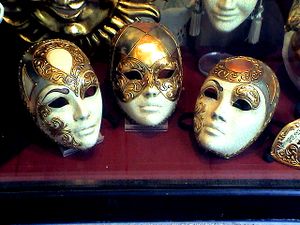
In the 14th century, many young Venetian men began wearing tight-fitting multicoloured hose, the designs on which indicated the Compagnie della Calza ("Trouser Club") to which they belonged. The Senate passed sumptuary laws, but these merely resulted in changes in fashion in order to circumvent the law. Dull garments were worn over colourful ones, which then were cut to show the hidden colours — which resulted in the wide spread of men's "slashed" fashions in the 15th century.
مشاهير البنادقة
للأشخاص من البندقية, انظر أشخاص من البندقية. وهناك آخرون تقترن أسماؤهم بشدة بالمدينة منهم:
- إنريكو دندولو (c. 1107, 1205), دوگه البندقية من 1192 إلى وفاته. He played a direct role in the sack of Constantinople during the الحملة الصليبية الرابعة.
- ماركو پولو (September 15 - 1254 January 8, 1324) was a trader and explorer one of the first Westerners to travel the Silk Road to China. While a prisoner in Genoa, he dictated in French the tale of his travels known as "Le Livres des Merveilles" - in Italian: Il Milione (The Travels of Marco Polo).
- جيوڤاني بليني (ح. 1430-1516), he was a Renaissance painter, probably the best known of the Bellini family of painters.
- ألدوس مانوتيوس (1449-1515), he has been the most important printer of history.
- پيترو بمبو (20 مايو, 1470 - 18 January, 1547), كاردينال وعالم.
- لورنزو لوتو (ح.1480 - لورتو, 1556) كان painter draughtsman and illustrator, traditionally placed in the Venetian school.
- سباستيان كابوت (c. 1484 – 1557, or soon after), was an explorer.
- تيتيان (ح. 1488-90 – August 27, 1576), was the leader of the 16th century Venetian school of the Italian Renaissance (he was born in Pieve di Cadore).
- ماركو أنطونيو براگادين (d.1571) جنرال سـُلِخ حياً من قِبل الأتراك بعد ابدائه مقاومة شرسة أثناء حصار فاماگوستا
- سباستيانو ڤنير, (ح. 1496 - March 3, 1578) was Doge of Venice from June 11, 1577 to 1578.
- أندريا گابرييلي (ح.1510–1586), Italian composer and organist at San Marco di Venezia
- تينتورتو (1518 - May 31, 1594), probably the last great painter of Italian Renaissance.
- ڤـِرونيكا فرانكو (1546-1591), شاعر وموظف بالبلاط أثناء عصر النهضة
- جيوڤاني گابرييلي (بين 1554 and 1557–1612), composer and organist at San Marco di Venezia
- كلاوديو مونتـِڤـِردي (1567-1643) composer and director of music at San Marco
- Baldassare Longhena (1598 - February 18 1682), كان أحد أعظم رواد طراز الباروك المعماري.
- توماسو ألبينوني (June 8, 1671 - January 17, 1751) was a baroque composer
- روزالبا كاريرا (October 7, 1675 – April 15, 1757), She became known for her pastel works.
- أنطونيو ڤيڤالدي (March 4, 1678, July 28 (or 27), 1741, Vienna), famous composer and violinist of the Baroque Era
- پيترو گوارنري (April 14, 1695 - April 7, 1762) left Cremona in 1718, settled in Venice. "Peter of Venice" from the family of great luthiers.
- جيوڤاني باتيستا تيپولو (March 5, 1696 - March 27, 1770), he was the last "Grand Manner" fresco painter from the Venetian Republic.
- كنالـِتو (October 28, 1697 - April 19, 1768), was a famous artist for his landscapes or vedute of Venice, but not only.
- كارلو گولدوني (25 فبراير, 1707 - 6 فبراير, 1793), مع پيراندلو, Goldoni is probably the most famous name in Italian theatre, in his country and abroad.
- كارلو گوتزي (13 December 1720 – April 4, 1806), he was an excellent dramatist of 18th century.
- جاكومو كازانوڤا (1725 - 1798), in Dux, بوهميا, (الآن دوخكوڤ, الجمهورية التشيكية) was a famous Venetian adventurer, writer and womanizer.
- كارلو سكارپا (June 2, 1906 - 1978, Sendai, اليابان), كان معمارياً ذا فهم عميق للمواد.
- إميليو ڤدوڤا (August 9 1919), one of the most important modern painters of Italy
- إلينا لوكرزيا كورنارو پيسكوپيا (June 5 1646 - July 26 1684), she was the first woman in the world to receive a doctorate degree.
- برونو مادرنا (April 21 1920 - November 13 1973), he was an Italian-German orchestra director and 20th century music composer.
- لويجي نونو (29 January 1924 - 8 May 1990), He became a leading composer of instrumental and electronic music.
- Ludovico de luigi (November 1933), Venetian Surrealistic artist.
كلمات أجنبية من أصل بندقي
- arsenal, ciao, ghetto, gondola, lazaret, lagoon, lido, quarantine, Montenegro, regatta.
- "Venezuela" means "little Venice".
مدن شقيقة
 Suzhou، الصين (1980)
Suzhou، الصين (1980) تالين، إستونيا
تالين، إستونيا إسطنبول، تركيا (1993)
إسطنبول، تركيا (1993) سراييڤو، البوسنة والهرسك (1994)
سراييڤو، البوسنة والهرسك (1994) نورنبرگ، ألمانيا (1999)
نورنبرگ، ألمانيا (1999) Kedke، اليونان (2000)
Kedke، اليونان (2000) Qingdao، الصين (2001)
Qingdao، الصين (2001) سالونيك، اليونان (2003)
سالونيك، اليونان (2003) سانت بطرسبرگ، روسيا (2006-2013)، في 30 يناير 2013، ألغت البندقية التوأمة بعد تمرير سانت بطرسبرگ قانون يخص المثليين.[3]
سانت بطرسبرگ، روسيا (2006-2013)، في 30 يناير 2013، ألغت البندقية التوأمة بعد تمرير سانت بطرسبرگ قانون يخص المثليين.[3] فورت لودردال، فلوريدا، الولايات المتحدة (2007)
فورت لودردال، فلوريدا، الولايات المتحدة (2007)
اتفاقيات تعاون
Venice has cooperation agreements with the Greek city of Thessaloniki, the German city of Nuremberg, signed on September 25, 1999, and a the Turkish city of Istanbul, signed on March 4, 1993, within the framework of the 1991 Istanbul Declaration. It is also a Science and Technology Partnership City with Qingdao, الصين.
The City of Venice and the Central Association of Cities and Communities of Greece (KEDKE) established, in January 2000, in pursuance of the EC Regulations n. 2137/85, the European Economic Interest Grouping (E.E.I.G.) Marco Polo System to promote and realise European projects within transnational cultural and tourist field, particularly referred to the artistic and architectural heritage preservation and safeguard.
فيضانات
ضربت ظروف جوية قاسية عدة أجزاء من إيطاليا ، مما تسبب في اضطرابات شديدة في النقل وانقطاع للكهرباء وحوادث مميتة في جميع أنحاء البلاد. وأصدرت الوكالة الوطنية للحماية المدنية تحذيرات من سوء أحوال الطقس مع اجتياح العواصف مناطق كثيرة من البلاد، متسببة في سقوط أمطار غزيرة وهبوب رياح قوية. تسببت تلك الفيضانات في اغراق البندقية في ايطاليا ، حيث ارتفع منسوب المياه إلى 1.87 متر في المدينة التاريخية، التي تم إدراجها على قائمة مواقع التراث العالمي التابعة لمنظمة اليونسكو، ما تسبب في قطع الكهرباء عن المنازل. [4]
انظر أيضاً
- Venice Film Festival
- Venice Biennale
- List of painters and architects of Venice
- List of architecture monuments of Venice
- Veneti and Venetic language (the ancient spoken language of the region)
- Venetian language (the modern spoken vernacular of the region)
- Venetian glass
- Su e zo per i ponti
- Venezia Mestre Rugby FC - rugby team
- Several European cities have been nicknamed Venice : The Venice of the West for the Breton city Nantes, and The Venice of the North for three cities : Brugge and Amsterdam in the Benelux and Stockholm in Sweden.
المصادر
- ^ Bosio, Le origini di Venezia
- ^ Santa Maria della Salute Church
- ^ "Venice suspends sister city with St Petersburg over gay bill". ansa.com. 2013-01-30. Retrieved 2013-01-30.
- ^ "فيضانات بإيطاليا تقضى على المحاصيل الزراعية وتتسبب فى إجلاء السكان". بي بي سي. 2019-11-14. Retrieved 2019-11-15.
كتب
- Bosio, Luciano. Le origini di Venezia. Novara: Istituto Geografico De Agostini.
- Chambers, D.S. (1970). The Imperial Age of Venice, 1380-1580. London: Thames & Hudson. The best brief introduction in English, still completely reliable.
- Contarini, Gasparo (1599). The Commonwealth and Gouernment of Venice. Lewes Lewkenor, trsl. London: "Imprinted by I. Windet for E. Mattes." The most important contemporary account of Venice's governance during the time of its blossoming. Also available in various reprint editions.
- Drechsler, Wolfgang (2002). "Venice Misappropriated." Trames 6(2), pp. 192-201. A scathing review of Martin & Romano 2000; also a good summary on the most recent economic and political thought on Venice.
- Garrett, Martin, "Venice: a Cultural History" (2006). Revised edition of "Venice: a Cultural and Literary Companion" (2001).
- Grubb, James S. (1986). "When Myths Lose Power: Four Decades of Venetian Historiography." Journal of Modern History 58, pp. 43-94. The classic "muckraking" essay on the myths of Venice.
- Lane, Frederic Chapin. Venice: Maritime Republic (1973) (ISBN 0801814456) standard scholarly history; emphasis on economic, political and diplomatic history
- Laven, Mary, "Virgins of Venice: Enclosed Lives and Broken Vows in the Renaissance Convent (2002). The most important study of the life of Renaissance nuns, with much on aristocratic family networks and the life of women more generally.
- Martin, John Jeffries and Dennis Romano (eds). Venice Reconsidered. The History and Civilization of an Italian City-State, 1297-1797. (2002) Johns Hopkins UP. The most recent collection on essays, many by prominent scholars, on Venice.
- Muir, Edward (1981). Civic Ritual in Renaissance Venice. Princeton UP. The classic of Venetian cultural studies, highly sophisticated.
- Rösch, Gerhard (2000). Venedig. Geschichte einer Seerepublik. Stuttgart: Kohlhammer. In German, but the most recent top-level brief history of Venice.
غيرها
- Morris, Jan (1993), Venice. 3rd revised edition. Faber & Faber, ISBN 0-571-16897-3. A subjective and passionate written introduction to the city and some of its history. Not illustrated.
- Ruskin, John (1853). The Stones of Venice. Abridged edition Links, JG (Ed), Penguin 2001. ISBN 0-14-139065-4. Seminal work on architecture and society
- di Robilant, Andrea (2004). A Venetian Affair. Harper Collins. ISBN 1-84115-542-X Biography of Venetian nobleman and lover, from correspondence in the 1750s.
وصلات خارجية
- Pages using gadget WikiMiniAtlas
- Short description is different from Wikidata
- Articles containing إيطالية-language text
- Articles containing Venetian-language text
- Coordinates on Wikidata
- صفحات تستخدم جدول مستوطنة بقائمة محتملة لصفات المواطن
- Pages using infobox settlement with image map1 but not image map
- Italian commune articles with missing parameters
- Pages using infobox Italian comune with unknown parameters
- Articles with hatnote templates targeting a nonexistent page
- Cities and towns in Veneto
- Communes of the Metropolitan City of Venice
- مدن كرنڤال
- Cities and towns in the Veneto
- مدن ساحلية
- جاليات يهودية تاريخية
- مدن موانئ في إيطاليا
- Sunken cities
- بلدان سابقة
- البندقية
- مواقع التراث العالمي في إيطاليا
- مدن رئيسية في إيطاليا
- صفحات مع الخرائط



